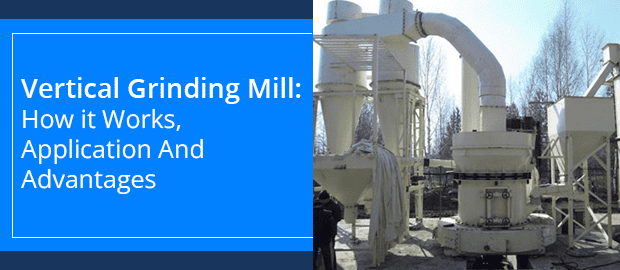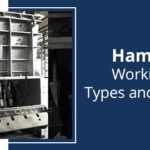As a highly efficient recycling powder making equipment, Vertical Grinding Mill (formerly known as Raymond mill crusher) is a widely used grinding machine suitable for processing non-flammable and non-explosive materials. It is suitable for construction, mining, metallurgy, pharmaceuticals, and chemical industries. The Vertical Grinding Mill is ideal for medium and small-scale industries as it requires less investment and low-power consumption compared to a ball mill.
1. What is a Vertical Grinding Mill?
The Vertical Grinding Mill (VGM) is an upright steel vessel with an inlet, an outlet and a central portion of the inlet. It is used for fine size reduction when output to input reduction required is large. These mill crushers consist of a reducing rotating mill for size reduction. The whole closed circuit is under a negative draft, and the finished material is then classified and collected through the mill fan out.
1.1 Advantages Vertical Grinding Roller Mill Machine
- As a vertical structure, this mill has a small footprint but a strong set of integrity. It can work as a self-contained independent production system for conveying raw materials, milling and final packing.
- Compared to others, this grinding mill has a high screening rate. The sieve size finished by the mill can reach more than 99%, which is not the case with other milling equipment.
- The electromagnetic vibration feeder feeds uniformly, is easy to adjust, small in size, lightweight, easy to maintain and saves power.
- The significant parts of a vertical grinding mill is made from high-quality castings and rigorous processes ensure high durability.
- Due to its advanced technology, dust pollution is reduced.
- Parts of the Vertical Grinding Mill are easy to access and maintain.
- The cost of these mills is less than that of the ball mill.
Learn How Vertical Grinding Can Boost Your Productivity
2. Working Principle of Vertical Grinding Mill
- The Vertical Grinding Mill working principle is simple and begins with the jaw crusher crushing the raw material to the required size.
- The crushed material is then added to the hopper (situated on the side of the hood) of the machine. From here, the material is continuously transported through the electro-magnetic vibrating feeder into the grinding mill chamber.
- Next, due to the action of the centrifugal force, the rollers oscillate outward to press against the grinding ring, while the shovel scoops up the materials and sends it between the roller & grinding ring to pulverised (grind) the material.
- The grounded raw material is then carried through the air from the blower into the Analyzer Machine for screening.
- The fine powder is then collected into the air cyclone collector and expelled from the output-powder valve as the final product.
- Whereas, the coarse material is sent back to the grinding chamber for regrinding. The machine’s airflow system is closely sealed up and the air is circulated under negative pressure.
2.1 Application or Uses of Vertical Grinding Mill
Vertical Grinding Mill’s are used to grind various insulation materials, phosphate rocks, cement, activated clay or carbon, limestone, marble, glass, plaster, etc. It enables the grinding and processing of more than 280 kinds of non-flammable and non-explosive materials with a hardness lesser than 7 and humidity less than 6%.
2.2 Maintenance of Vertical Grinding Mill
- The operator needs to be knowledgeable about the application, its principle and the operating process of the mill.
- Necessary lubricants, maintenance tools and accessories are required.
- The bolts and nut plugs should be checked frequently before & after using the grinding roller device.
- The wearing parts, such as the grinding ring, blade, grinding roller, and liner, need to be checked for wear & tear and replaced accordingly.
3. Different Parts of Vertical Grinding Mill (VGM)
As an independent grinding machine, the parts of VGM consists of optimising grinding unit, classifier, cyclone air separator & tank, centrifugal blower, dust collector & connecting pipes, belt conveyor/feeder. The operation of each component that is used for crushing is explained in detail below.
3.1 Optimising Grinding Unit
- The heavy type roller assembly has robust strength. Whereas, the roller and the ring are made with wear-resistant materials, which helps extend the product usage life. The roller adopts a multi-layer block system, which is reliable and durable. This helps reduce the cost and time for maintenance.
- The top of the grinding mill and the grinding chamber bottom is manufactured using heavy-duty cast iron. The bottom consists of tangential ports from where air can enter the mill. Whereas, the inspection door is provided on the top for accessing the rollers and inside of the mill.
- The rollers run on their own anti-friction bearing while travelling around the Bull Ring. A replaceable alloy steel bull ring is fitted in the grinding chamber bottom against which the rollers revolve. Cast ploughs are firmly attached near the bottom end of the main shaft, while the drive end of the main shaft consists of a heavy-duty gearbox.
- The belt conveyor feeds material into the grinding chamber top. Supports for the bracket are also provided on the top to secure the cast iron bracket in between, while the main shaft, made of alloy steel, runs on an anti-friction heavy-duty bearing.
3.2 Classifier
- They are equipped with a Whizzer type classifier for the separation of coarse stone particles from fine ones.
- The classifier is made of a heavy-duty mild steel plate and is driven through a bevel gear arrangement.
- The fineness of the stone can be controlled by setting the R.P.M of the classifier wheel and/or adjusting the gap between the impeller blades.
- The R.P.M can be varied depending upon the fineness and production required. Higher the R.P.M, higher the fineness and lower the production.
3.3 Cyclone Air Separator and Airlock Valve
- The function of the cyclone is to separate the grounded stone from the air. It is connected to the classifier through the bend and pipe. A rotatory airlock valve is provided along with the gearbox and located at the discharge end of the cyclone. The stone powder is continuously discharged from the airlock valve.
- Cyclone classifier and cyclone pipe along with its bend are fabricated out of heavy-duty mild steel sheet.
3.4 Centrifugal Blower
The centrifugal blower is made of a thick M.S plate lined inside with suitable types of liners, consisting of an independent V-belt drive. The blower impeller is statistically and dynamically balanced.
3.5 Dust Collector and Connecting Pipes
An open-type dust collector is used to filter out excess air from the mill and capture fine dust particles in the dust collector bags.
3.6 Belt Conveyor/Feeder
A belt conveyor or feeder is provided for feeding raw stones in the mill. The lumps of the stones are put into the hopper.
#Macawber’s Denseveyor Pneumatic Conveying System
The Denseveyor pneumatic conveying system is used once the material is crushed. It is mounted below the outlet of the intermediate hopper, which receives the material from the cyclonic separator & bag filter outlet through a screw feeder. The material is then conveyed into the reception silo.
- As a standard configuration, there is a manual knife gate valve (KGV) at the outlet of the feed hopper for maintenance of the Denseveyor components
- Along with it comes the dome valve and the Denseveyor control panel. The entire operation of the pneumatic conveying system is automated and controlled by a PLC-based control panel.
- When the level-probe sends a signal of sufficient material, the dome valve opens to fill the vessel with materials. Once filled, the dome valve is closed, and the inflatable seal expands to provide complete isolation/sealing.
- Following this, compressed air is introduced into the vessel, which aerates the material. The material is then conveyed to the reception silo via the conveying pipeline and terminal box arrangement.
- The reverse pulse jet filter, mounted on top of the reception silo, then filters and separate the air/material from each other.
A Vertical Grinding Mill accompanied by a pneumatic conveying system can turn out to be the best choice for grinding or crushing. Hence, make a well-informed decision and if you have any queries, contact us, and we’ll be happy to assist you.



